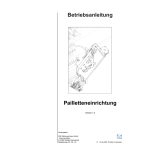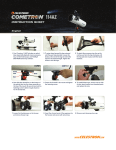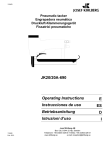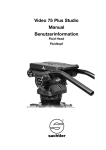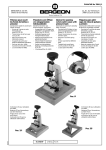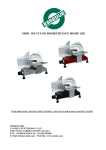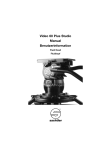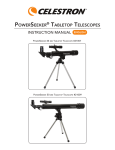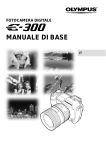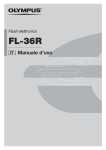Download G2180 fluid head 1 2 1 2 2 1 2 1 2 2 3
Transcript
2 3 1 Deutsch 4 FIG. 1 Einstellung Der Kopf kann in zwei verschiedenen Konfigurationen benutzt werden: - ohne Schwenkgriff, typisch für Vogelbeobachtung/Foto-Einsatz - mit Schwenkgriff, typisch für Video-Einsatz 1 A FIG. 2 – Zusammenbau des Schwenkgriffs Der Kopf wird mit einem nicht montierten Schwenkgriff geliefert. Bauen Sie den Schwenkgriff wie folgt zusammen: 1. Entfernen Sie die kleine “Nase” “A”, indem Sie Schraube “B” lösen ANMERKUNG: bitte bewahren Sie die „Nase“ “A” an einem sicheren Ort für späteren Einsatz auf. 2. Setzen Sie Schraube “B” in Kopf “C” ein 3. Befestigen Sie den Schwenkgriff, setzen Sie den Einstellkopf “C” auf den Stativkopf auf und ziehen Sie die Schraube “B” mit einer Münze fest. Der Einstellkopf “C” ist so ausgelegt, den Schwenkgriff in verschiedenen Positionsintervallen zu bewegen und ebenfalls, um für Links- und Rechtshänder montiert werden zu können. B 2 90 45 2 0 C FIG. 4 – Das Equipment auf der Platte befestigen 6 E FIG. 3 – Die Kameraplatte entfernen 7 FIG. 5 – Das Equipment am Kopf befestigen Stellen Sie sicher, dass Schraube “E” gelöst ist und setzen Sie die Platte an, wie in der Figur gezeigt. Sperren Sie die Platte, indem Sie Schraube “E” in Uhrzeigersinn festziehen. Anmerkung: die Schnelllöseplatte kann aufgrund des Sicherungsstiftes nur in einer Richtung eingesetzt werden. 8 ON 5 2 B OFF F F OF OFF 3 10 11 12 13 14 F ON FIG. 8 – drehen Sie mit einer Hand den Knopf “H” auf die “ON” Position (dem Pfeil folgend). FIG. 9 - wenn das Equipment sich nicht bewegen sollte, bedeutet dies, dass Sie die korrekte Ausgleichseinstellung gefunden haben OF 16 17 2 ON OFF +2 FIG. 10 – wenn das Equipment kippen sollte, suchen Sie den Balance-Punkt wie folgt: 1 -2 OFF 1. FIG. 11 – ziehen Sie den Knopf “H” heraus und drehen Sie ihn auf die “OFF” Position 2. FIG. 12 – drehen Sie Ihr Equipment in die Richtung, in die es kippt 3. FIG. 13 – stellen Sie Position „1“ ein, indem Sie „-1“ oder „+1“ wählen, entsprechend der Kipprichtung (immer entgegen der Kipprichtung), und drehen Sie den Knopf “H” auf die “ON” Position, bis er in der Position bleibt. ANMERKUNG: wenn der Knopf auf der “ON” Position ist, befindet er sich in der Position, die dem Kopf am nächsten ist. 4. FIG. 14 – Prüfen Sie, ob sich das Equipment nicht bewegt: dies bedeutet, dass Sie den Balance-Punkt gefunden haben. FIG. 15 - Wenn das Equipment kippen sollte, wiederholen Sie die obigen Anweisungen und wählen Position “+/- 2“ oder “+/- 3“. Die Position “+/-3” ist die maximale Einstellposition. N ON ON F OF F 2 G2180 fluid head Der Kopf kann mit oder ohne Ausgleichssystem benutzt werden. FIG. 7 - Lösen Sie die Schraube “F”, während Sie Ihr Equipment halten, um ein Umkippen zu vermeiden - bewegen Sie das Equipment, um die “0” Position (durch den Pfeil angegeben) zu erreichen OFF 15 ON Wenn Sie den Kopf mit dem Ausgleichssystem nutzen möchten, gehen Sie wie folgt vor: ON OFF ON FIG. 6-7-8-9-10-11-12-13-14-15 – Geweichtsausgleichssystem Der Kopf ist mit einem Gewichtsausgleichssytem über Federspannung ausgestattet (ON/OFF, 7 Positionen), um dem dezantralen Gewicht/ den Kippkräften Ihres Equipments entgegenzuwirken. Der Kopf kann Lasten bis zu 4 kg (8.8 lbs) aufnehmen und das Ausgleichssystem kann dezentrale/Kipplasten von bis zu 2,5 kg (5.5 lbs) ausgleichen. FIG. 6 – Ohne Ausgleichssystem verhält sich der Kopf wie ein Standard-Fluid-Kopf: 1. Vergewissern Sie sich, dass die Kipp-Feststellschraube festgezogen ist. 2. ziehen Sie mit einer Hand den Knopf “H” heraus und drehen Sie ihn auf die “OFF” Position (dem Pfeil folgend). 3. mit der anderen Hand halten Sie Ihr Equipment und lösen den Knopf “F” ANMERKUNG: wenn der Knopf auf der “OFF” Position ist, befindet er sich in der Position, die am weitesten vom Kopf entfernt ist (siehe Detail). F F OFF ON 9 H 2 OFF ON 1 H instructions mode d’emploi istruzioni Gebrauchsanweisung FIG 16 - Entfernen der Kamera vom Kopf FIG. 17 – Benutzen Sie die N Schwenk-Steuerschraube: Reibung und Sperre (360º) F Kipp-Steuerschraube: Reibung und Sperre (+90º/-90º) G2,5015 - 06/08 1 1 2 3 1 4 1 A 45 B 2 0 C 2 B 6 E 7 FIG. 5 – How to mount the equipment on the head Make sure that knob “E” is unscrewed and insert the plate as shown in figure. Lock the plate in position by screwing knob “E” in a clockwise direction. Note: the quick release plate can be inserted in one direction only due to the safety pin. 8 FF O OFF 3 H 10 11 12 13 14 OFF ON F OF 15 16 1 17 ON FIG. 10 - if the equipment falls, find the balance point as follow 1. FIG. 11 - rotate and pull out the knob “H” to “off” position 2. FIG. 12 - rotate your equipment in the opposite direction of the fall 3. FIG. 13 - reach position “1” selecting “-1” or “+1” accordingly to the direction of the fall (always opposite direction) and rotate the knob “H” to “ON” position until it locks into position NOTE: when set in “on” position, the knob stays in the closest position to the head 4. FIG. 14 - check if the equipment doesn’t move: it means that you have reached the balance point ON OFF ON FIG. 6-7-8-9-10-11-12-13-14-15 – Counter balance system The head is provided with a spring loaded counter balance system (ON/OFF, 7 positions) to balance the off centre weight of your equipment. The head is able to support loads up to 4 kg (8.8 lbs), and the balance system allows to balance a off centre load up to 2,5 kg (5.5 lbs) The head can be used with or without counter balance system. FIG. 6 - Without counter balance system the head behaves like a standard fluid head: 1. make sure that the tilt control knob “F” is tightened 2. with one hand pull out and fully rotate the knob “H” to “OFF” position (following the arrow) 3. with the other hand hold your equipment and unscrew the knob “F” NOTE: when set in “off” position, the knob stays in the furthest position from the head (see detail) If you want to use the head with counter balance system, proceed as follow: FIG. 7 - unscrew the knob “F” while holding your equipment in order to prevent it from suddenly flopping - move the equipment in order to reach the “0” position (indicated by arrow) FIG. 8 - with the other hand fully rotate the knob “H” to “ON” position (following the arrow) FIG. 9 - if the equipment doesn’t move, it means that you have reached the balance point F F OFF ON 9 H 2 OFF ON 1 FIG. 1 - Preparazione La testa può essere usata in due diverse configurazioni: senza leva di comando, tipicamente preferita per birdwatching e fotografia con leva di comando, tipicamente preferita per impieghi Video FIG. 4 – How to mount the equipment on the plate OFF F Italiano FIG. 1 – Installation La rotule fluide G2180 peut être utilisée dans deux types de configurations différentes : - sans levier, pour l’observation animalière ou la photo, - avec levier, pour la vidéo. FIG. 3 – How to remove the camera plate ON 5 Français FIG. 1 Set up The head can be used in two different configurations: - without handle bar, typically for Bird Watching/Photo use - with handle bar, typically for Video use FIG. 2 – Assemble Handle Bar The head is supplied with handle bar not assembled. Assemble the handle bar as follow: 1. Remove small “nose” “A” by unscrewing the screw “B” NOTE: please store the “nose” “A” in a safe place for future use 2. Insert the screw “B” into quadrant “C” 3. Attach the handle bar, position the adjustment quadrant “C” on the head and secure with screw “B” using a coin. The adjustment quadrant “C” is designed to allow the handle bar to be positioned at various intervals and also to be rotated at full 360° for right/left hand users 2 90 English F FIG. 15 If the equipment falls down, repeat the instructions above, selecting position “-/+2” or “-/+3”. Position “-/+3” is the maximum setting. FIG. 16 - Remove equipment from the head FIG. 17 Use N Pan control knob: friction and lock (360°) F Tilt control knob: friction and lock (+90/-90°) 2 ON OFF +2 -2 OFF FIG. 3 – Retrait du plateau rapide FIG. 4 – Fixation de l’appareil sur le plateau rapide FIG. 5 – Fixation de l’appareil sur la rotule Assurez-vous que la molette “E” est dévissée, puis insérez le plateau tel qu’illustré à la figure 5. Bloquez le plateau en position en faisant tourner la molette “E” dans le sens des aiguilles d’une montre. Remarque : le plateau rapide ne peut être inséré que dans une seule direction en raison de la goupille de sécurité. FIG. 6-7-8-9-10-11-12-13-14-15 – Système de contre-balancement La rotule fluide G2180 est équipée d’un système de contrebalancement à ressort (ON / OFF - marche / arrêt, 7 positions) permettant de compenser le déséquilibre du poids de l’appareil. La rotule peut supporter des charges jusqu’à 4 kg, et le système de contre-balancement permet de compenser le déséquilibre d’une charge allant jusqu’à 2,5 kg. La rotule peut être utilisée avec ou sans système de contrebalancement. FIG. 6 – Sans système de contre-balancement, la rotule agit comme une rotule fluide standard : 1. assurez-vous que le bouton de réglage du mouvement de bascule “F” est bien serré, 2. d’une main, tirez le bouton “H” vers l’extérieur puis faites-le complètement tourner dans le sens inverse des aiguilles d’une montre pour atteindre la position “OFF”, 3. de l’autre main, maintenez votre appareil et dévissez le bouton “F”. Remarque : en position “OFF”, le bouton “H” se trouve dans la position la plus éloignée de la rotule (voir illustration). Si vous voulez utiliser la rotule sans système de contre-balancement, suivez les instructions suivantes : FIG. 7 - dévissez le bouton “F” tout en maintenant l’appareil afin d’éviter qu’il ne s’incline, - déplacez l’appareil de façon à ce que le repère de l’échelle graduée soit sur la position “0”, tel qu’illustré à la figure 7. FIG. 8 – Tirez le bouton “H” vers l’extérieur puis faites-le complètement tourner dans le sens inverse des aiguilles d’une montre pour atteindre la position “OFF”. FIG. 9 – Si l’appareil ne bouge pas, cela signifie que vous avez atteint le point d’équilibre. FIG. 10 – Si l’appareil s’incline, recherchez le point d’équilibre en suivant les instructions suivantes : 1. FIG. 11 – Tirez le bouton “H” vers l’extérieur et faites-le tourner pour atteindre la position “OFF”. 2. FIG. 12 – Placez votre appareil dans la direction opposée à celle où il s’incline. 3. FIG. 13 – Déplacez l’appareil dans la direction opposée à celle où il s’incline jusqu’à obtenir la position 1 en utilisant les repères “-1” ou “+1” selon le sens d’inclinaison de l’appareil, puis faites tourner le bouton “H” sur la position “ON” jusqu’à ce qu’il se bloque en position. Remarque : en position “ON”, le bouton se trouve dans la position la plus proche de la rotule. 4. FIG. 14 – Vérifiez que l’appareil ne bouge pas : si tel est le cas, cela signifie que vous avez atteint le point d’équilibre. FIG. 15 - Si l’appareil penche vers l’avant, répétez la procédure décrite ci-dessus en sélectionnant la position “-/+2” ou “-/+3”. La position “-/+3” correspond au réglage maximum. N ON ON F OF FIG. 2 – Montage du levier La rotule est livrée avec le levier non monté. Suivez les instructions suivantes pour monter le levier : 1. Faites tourner la vis “B” dans le sens inverse des aiguilles d’une montre afin de pouvoir retirer la rondelle “A”. Remarque : conservez la rondelle “A” dans un endroit sûr afin de pouvoir la réutiliser ultérieurement. 2. Insérez la vis “B” dans l’axe “C”. 3. Fixez le levier en positionnant l’axe de réglage “C” sur la rotule. Vissez l’ensemble en faisant tourner la vis “B” dans le sens des aiguilles d’une montre à l’aide d’une pièce de monnaie. L’axe de réglage “C” permet de positionner le levier à diverses positions et de pouvoir le tourner complètement à 360° pour qu’il s’adapte à tous les utilisateurs, gauchers ou droitiers. 2 FIG. 16 – Retrait de l’appareil de la rotule FIG. 17 – Application N Bouton de réglage du mouvement panoramique : friction et blocage (360°) F Bouton de réglage du mouvement de bascule : friction et blocage (+90/-90°) FIG. 2 - Montaggio della leva di comando La testa è fornita con leva di comando smontata. Procedura per montare la leva di comando: 1. Rimuovere il “cono” “A” svitando la vite “B” NOTA: conservare il “cono” “A” in luogo sicuro per un possibile uso successivo 2. Inserire la vite “B” nel quadrante dentellato “C” 3. Attaccare la leva, posizionare il quadrante di regolazione “C” sulla testa e fissarlo saldamente con la vite “B”, serrandola con una moneta. Il quadrante di regolazione “C” consente di posizionare la leva a diverse angolazioni su 360° per adattarsi ad utenti destri e mancini FIG. 3 - Smontaggio della piastra dalla testa FIG. 4 - Montaggio dell’apparecchio sulla piastra FIG. 5 - Montaggio dell’apparecchio sulla testa Accertarsi che il pomello “E” sia svitato e inserire la piastra come mostrato in figura. Bloccare la piastra in posizione avvitando il pomello “E” in senso orario. Nota: la piastra a sganciamento rapido può essere inserita in una sola direzione per via del pernino di sicurezza. FIG. 6-7-8-9-10-11-12-13-14-15 - Sistema di controbilanciamento La testa è fornita di un sistema per il controbilanciamento a molla precaricata (ON/OFF, 7 posizioni) per compensare il peso sbilanciato dell’apparecchio in uso. La testa può portare pesi fino a 4 kg, mentre il sistema di bilanciamento può compensare uno squilibrio di peso fino a 2,5 kg La testa può essere usata con il sistema di controbilanciamento attivato o disattivato. FIG. 6 - Con il sistema di controbilanciamento disattivato la testa si comporta come una normale testa fluida: 1. accertarsi che la ghiera di controllo dell’inclinazione “F” sia stretta 2. con una mano estrarre e ruotare a fondo il pomello “H” portandolo in posizione “OFF” (come indicato dalla freccia) 3. con l’altra mano reggere l’apparecchio e svitare la ghiera “F” NOTA: in posizione “OFF” il pomello rimane scostato dalla testa (vedere dettaglio) Per usare la testa col sistema di controbilanciamento, procedere come indicato di seguito: FIG. 7 - svitare la ghiera “F” mentre si regge l’apparecchio per evitarne la caduta - portare l’apparecchio sulla posizione “0” (indicata dalla freccia) FIG. 8 - con l’altra mano ruotare il pomello “H” portandolo in posizione “ON” (come indicato dalla freccia) FIG. 9 - se l’apparecchio non si muove è stato raggiunto il punto di bilanciamento FIG. 10 - se l’apparecchio tende ad inclinarsi, trovare il punto di bilanciamento come indicato di seguito 1. FIG. 11 - ruotare ed estrarre il pomello “H” sulla posizione “OFF” 2. FIG. 12 - inclinare l’apparecchio in direzione opposta a quella di caduta 3. FIG. 13 - inserire un valore di compensazione “1” selezionando “-1” o “+1” in base alla direzione di caduta e ruotare il pomello “H” sulla posizione “ON” fino a farlo bloccare in posizione NOTA: in posizione “OFF” il pomello rimane accostato alla testa 4. FIG. 14 - verificare che l’apparecchio non tenda ad inclinarsi. Se l’apparecchio non si muove è stato raggiunto il punto di bilanciamento FIG. 15 - Se l’apparecchio tende ad inclinarsi, ripetere la procedura riportata più sopra, selezionando una posizione “-/+2” o “-/+3”. La posizione “-/+3” indica il massimo controbilanciamento possibile. FIG. 16 - Smontaggio dell’apparecchio dalla testa FIG. 17 Uso N Pomello di controllo della panoramica: frizione e blocco (360°) F Ghiera di controllo dell’inclinazione: frizione e blocco (+90/-90°)



